Urban Energy Transitions in Europe, towards Low-Socio-Environmental Impact Cities
Abstract
:1. Introduction
- What are the relationships, if any, between renewable energy production, local energy transition resources and GHG emissions and total energy consumption?
- Is there a link between the geopolitical and/or climate situation and GHG emissions or total energy consumption?
2. Methodology
2.1. Data Collection
2.2. Survey Data Validation Methodology
2.3. Statistical Analysis Methodology
3. Results
3.1. Energy Transition Data Accessibility
3.2. Energy Consumption Rates, GHG Emission Rates, Renewable Generation and Climatic Factors
3.2.1. Energy Consumption vs. GHG Emissions
3.2.2. Renewable Generation vs. Population Density, Energy Consumption and GHG Emissions
3.2.3. Climatic Factors vs. Energy Consumption and GHG Emissions
3.2.4. Annual GHG Emission Rates in Local Authorities
3.3. Impact of Energy Transition Policies at Local Authority Level
3.4. Regrouped Locations, Averages and Effects
4. Discussion of Results
4.1. Research Findigs
- #9.1: Transition budget, transition staff, energy staff, total renewable energy generated, municipality-led campaigns for the last three years and citizen- or cooperative-led campaigns present strong positive correlations. However, they are not correlated with new renewable generation power projects, nor with campaigns in the past.
- #9.2: Attending to the amount of correlations they present, transition budget and transition staff are identified as key factors.
4.2. Answers to Research Questions
4.2.1. Main Variables Affecting the Energy Transition
4.2.2. Relationships between Renewable Energy Production, Local Energy Transition Resources, GHG Emissions and Total Energy Consumption
4.2.3. Link between the Geopolitical and/or Climate Situation and GHG Emissions or Total Energy Consumption
5. Conclusions
Author Contributions
Funding
Institutional Review Board Statement
Informed Consent Statement
Data Availability Statement
Acknowledgments
Conflicts of Interest
Appendix A
| Country | Name of Local Authority | Abreviated Name | M/D | Inhabitants |
|---|---|---|---|---|
| Austria | Vienna | Vienna | M | 1,911,191 |
| Belgium | Ghent | Ghent | M | 263,927 |
| Ranst | Ranst | M | 19,187 | |
| Bosnia & H. | Zenica | Zenica | M | 109,679 |
| Burgas | Burgas | M | 210,000 | |
| Bulgaria | Dobrich | Dobrich | M | 82,240 |
| Silistra | Silistra | M | 44,940 | |
| Dubrovnik | Dubrovnik | M | 44,743 | |
| Krizevci | Krizevci | M | 21,000 | |
| Croatia | Rijeka | Rijeka | M | 128,000 |
| Velika Gorica | Velika | M | 63,517 | |
| Zagreb | Zagreb | M | 807,254 | |
| Cyprus | Aradippou | Aradippou | M | 19,228 |
| Nicosía (South) | Nicosía | M | 55,014 | |
| Czech R. | Litomerice | Litomerice | M | 25,000 |
| Denmark | Frederikshavn | Frederikshavn | M | 61,000 |
| Finland | Tampere | Tampere | M | 232,000 |
| Auxerre | Auxerre | M | 34,634 | |
| France | Grenoble | Grenoble | M | 451,096 |
| Metz | Metz | M | 222,000 | |
| Georgia | Tbilisi | Tbilisi | M | 1,184,818 |
| Germany | Frankfurt | Frankfurt | M | 750,000 |
| Mannheim | Mannheim | M | 324,009 | |
| Chalandri | Chalandri | M | 74,000 | |
| Greece | Illion (University of West Attica) | Illion | M | 84,793 |
| Komotini | Komotini | M | 66,919 | |
| Oichalias | Oichalias | M | 11,228 | |
| Atlantic Seaboard North (Donegal, Sligo, Mayo, Galway Climate Change Agency) | Atlantic | D | 613,292 | |
| Ireland | Dublin | Dublin | M | 553,165 |
| Kells | Kells | M | 6135 | |
| Meath County Council | Meath | D | 195,044 | |
| Acquappesa | Acquappesa | M | 1876 | |
| Falconara Albanese | Falconara | M | 1451 | |
| Mantova | Mantova | M | 48,835 | |
| Italy | Palma Campania, San Giuseppe Vesuviano and Striano | PC_SG_S | D | 54,750 |
| San Lucido | Lucido | M | 6223 | |
| Santorso | Santorso | M | 5236 | |
| Udine | Udine | M | 97,761 | |
| Lithuania | Tauragé | Tauragé | M | 43,853 |
| Montenegro | Podgorica | Podgorica | M | 622,028 |
| Alphen aan den Rijn | Alphen | M | 120,000 | |
| Amsterdam | Amsterdam | M | 854,316 | |
| Netherlands | Drechtsteden | Drechtsteden | D | 280,000 |
| Heerhugowaard | Heerhugowaard | M | 58,389 | |
| Heerlen | Heerlen | M | 86,935 | |
| Horst aan de Maas | Horst | M | 42,295 | |
| Palecznica | Palecznica | M | 3600 | |
| Poland | Piaseczno | Piaseczno | M | 79,861 |
| Warsaw | Warsaw | M | 1,790,658 | |
| Almada | Almada | M | 96,404 | |
| Portugal | Matosinhos | Matosinhos | M | 175,478 |
| Torres Vedras | Torres Vedras | M | 80,000 | |
| Vila Nova de Gaia | Vila | M | 299,938 | |
| Romania | Miercurea Ciuc | Miercurea | M | 41,971 |
| Mizil | Mizil | M | 14,312 | |
| Belgrade | Belgrade | M | 1,166,763 | |
| Serbia | Negotin | Negotin | M | 32,007 |
| Niš | Niš | M | 260,000 | |
| Šabac | Šabac | M | 110,148 | |
| Barcelona | Barcelona | M | 1,600,000 | |
| Cadiz | Cadiz | M | 119,000 | |
| Canet d’En Berenguer | Canet | M | 6697 | |
| Consell Comarcal Girones | CC_Girones | D | 197,104 | |
| Diputació de Barcelona | D_Barcelona | D | 5,664,579 | |
| El Prat de Llobregat | E_Prat | M | 65,385 | |
| Errenteria | Errenteria | M | 40,030 | |
| Spain | Logroño | Logroño | M | 152,485 |
| Lugo | Lugo | M | 98,276 | |
| Mollet del Vallès | Mollet | M | 51,600 | |
| Monachil | Monachil | M | 8007 | |
| Navarra | Navarra | D | 654,214 | |
| Pamplona | Pamplona | M | 203,944 | |
| Rubí | Rubí | M | 77,464 | |
| San Sebastian | San Sebastian | M | 180,989 | |
| Valencia | Valencia | M | 800,000 | |
| Sweden | Malmö | Malmö | M | 344,166 |
| Växjö | Växjö | M | 92,000 | |
| Adalar | Adalar | M | 15,238 | |
| Bornova (Izmir) | Bornova | M | 450,992 | |
| Turkey | Çorlu | Çorlu | M | 288,692 |
| Istanbul Metropolitan Municipality | Istanbul | M | 15,519,267 | |
| Kepez | Kepez | M | 30,436 | |
| Kirklareli | Kirklareli | M | 79,038 | |
| Coventry | Coventry | D | 363,242 | |
| Devon | Devon | D | 802,375 | |
| Manchester | Manchester | M | 2,700,000 | |
| Mendip | Mendip | D | 115,587 | |
| North Somerset Council | North Somerset | D | 213,919 | |
| UK | Nottingham | Nottingham | M | 330,000 |
| Plymouth | Plymouth | M | 260,000 | |
| Rochdale | Rochdale | M | 211,000 | |
| Sheffield City Region & West Yorkshire Combiend | Shef&W_York | D | 1,400,000 | |
| Wakefield Council | Wakefield | D | 348,312 | |
| West Lothian Council | West Lothian | D | 183,000 | |
| Wiltshire | Wiltshire | D | 500,024 | |
| Ukraine | Lviv | Lviv | M | 724,314 |
| Zhytomyr City Council | Zhytomyr | M | 264,318 |
| Name of Local Authority | rGHG [CO2-eq-t·cap−1·yr−1] | rTC [MWh·cap−1·yr−1] |
|---|---|---|
| Acquappesa | 2.61 | 9.56 |
| Adalar | - | - |
| Almada | 5.24 | 33.78 |
| Alphen aan den Rijn | 9.73 | |
| Amsterdam | 5.27 | 27.78 |
| Aradippou | 5.12 | 9.51 |
| Atlantic Seaboard North | - | - |
| Auxerre | 0.49 | - |
| Barcelona | 2.13 | 9.37 |
| Belgrade | - | - |
| Bornova (Izmir) | 2.00 | 6.02 |
| Burgas | 5.68 | 13.73 |
| Cadiz | 5.14 | 11.59 |
| Canet d’En Berenguer | - | - |
| Chalandri | 6.39 | 9.60 |
| Consell Comarcal Girones | 5.00 | - |
| Çorlu | - | - |
| Coventry | 3.58 | - |
| Devon | 10.34 | 28.66 |
| Diputació de Barcelona | 4.42 | - |
| Dobrich | 7.11 | 14.82 |
| Drechtsteden | 7.22 | 30.44 |
| Dublin | 7.96 | 19.58 |
| Dubrovnik | - | - |
| El Prat de Llobregat | 4.82 | 16.05 |
| Errenteria | 5.69 | 13.71 |
| Falconara Albanese | 1.35 | - |
| Frankfurt | 12.62 | 18.93 |
| Frederikshavn | 7.51 | 23.68 |
| Ghent | 5.48 | 26.06 |
| Grenoble | 3.73 | 28.71 |
| Heerhugowaard | - | - |
| Heerlen | 9.52 | - |
| Horst aan de Maas | 16.43 | 48.27 |
| Illion (University of West Attica) | 4.30 | 10.68 |
| Istanbul | 3.06 | 0.63 |
| Kells | - | - |
| Kepez | - | - |
| Kirklareli | - | - |
| Komotini | 8.04 | 11.64 |
| Krizevci | 3.80 | 7.11 |
| Litomerice | 3.27 | 22.02 |
| Logroño | 4.58 | 16.18 |
| Lugo | - | - |
| Lviv | 3.88 | 13.53 |
| Malmö | 1.53 | - |
| Manchester | 5.00 | 20.29 |
| Mannheim | 9.67 | 20.30 |
| Mantova | 5.14 | 19.89 |
| Matosinhos | 4.61 | 16.15 |
| Meath County Council | 7.45 | - |
| Mendip | 7.73 | 23.74 |
| Metz | 3.92 | 17.15 |
| Miercurea Ciuc | - | - |
| Mizil | 3.45 | 9.60 |
| Mollet del Vallès | 2.70 | 10.05 |
| Monachil | - | - |
| Navarra | 8.67 | 34.56 |
| Negotin | - | - |
| Nicosía (South) | - | 21.94 |
| Niš | 6.46 | 10.86 |
| North Somerset Council | - | - |
| Nottingham | 3.70 | 19.36 |
| Oichalias | 5.11 | 12.52 |
| Palecznica | 5.68 | - |
| Palma Campania, San Giuseppe Vesuviano and Striano | 4.07 | 10.63 |
| Pamplona | 5.04 | 22.82 |
| Piaseczno | 7.72 | 21.43 |
| Plymouth | 4.05 | 16.76 |
| Podgorica | 2.25 | - |
| Ranst | 5.95 | 29.76 |
| Rijeka | 3.80 | 13.96 |
| Rochdale | 4.41 | - |
| Rubí | 3.01 | 9.75 |
| Šabac | - | - |
| San Lucido | - | - |
| San Sebastian | 6.47 | 15.55 |
| Santorso | 6.17 | 19.75 |
| Sheffield City Region & West Yorkshire Combined | 7.93 | - |
| Silistra | - | - |
| Tampere | 8.28 | 26.18 |
| Tauragé | - | - |
| Tbilisi | 2.85 | 11.36 |
| Torres Vedras | 4.95 | 19.67 |
| Udine | 5.39 | 21.95 |
| Valencia | 2.45 | 9.89 |
| Växjö | 2.91 | 15.09 |
| Velika Gorica | 3.80 | 13.92 |
| Vienna | 4.37 | 19.76 |
| Vila Nova de Gaia | 5.47 | 19.26 |
| Wakefield Council | 9.09 | 25.47 |
| Warsaw | 6.55 | 15.19 |
| West Lothian Council | .20 | 0.63 |
| Wiltshire | 6.95 | 23.10 |
| Zagreb | 3.63 | 14.90 |
| Zenica | 2.31 | 5.80 |
| Zhytomyr City Council | 2.80 | 9.19 |
Appendix B. Baseline Survey for Energy Transition in mPower Digital
Appendix C. List of Variables Gathered during Data Collection
| Geographical DATA (Demographic, Climatic) | Acronym | Unit | Metadata | ||
|---|---|---|---|---|---|
| Name | N | - | Doc_link | - | Comments_questionaire |
| Country | C | - | - | - | - |
| Inhabitants | Inhab | - | Inhab_year | Inhab_source | Prac_comment |
| Area | A | km2 | - | Area_source | - |
| Temperature Increase | TI | °C | - | [69] | - |
| Heating Degree Days | HDD | Celsius-based degree days | HDD_year | [67] | - |
| Cooling Degree Days | CDD | Celsius-based degree days | CDD_year | [67] | - |
| Irradiance | Irrad | W/m2 | Irra_year | [70] | - |
| Wind_potential | WP | W/m2 | WP_year | [66] | - |
| Renewable Energy Generation Data | Unit | ||||
| Data Type | DTR | All/public | R_link | Source_R | R_Comments |
| Thermal Power | TP_MW | MW | TP_year | - | - |
| Thermal Energy | TE_MWh | MWh/year | TE_year | - | - |
| Electric Power | EP_MW | MW | EP_year | - | - |
| Electric Energy | EE_MWh | MWh/year | EE_year | - | - |
| Annual Energy Consumption | Unit | ||||
| Data Type | DTC | All/public | C_link | Source_C | C_Comments |
| Electricity | EC_MWh | MWh/year | EC_year | - | - |
| Natural_Gas | NG_MWh | MWh/year | NG_year | - | - |
| Liquid_Fuels | LF_MWh | MWh/year | LF_year | - | - |
| Coal | C_MWh | MWh/year | Coal_year | - | - |
| Biomass | B_MWh | MWh/year | B_year | - | - |
| Other energy type | - | - | - | ||
| Other Energy E | OE_MWh | MWh/year | OE_year | - | - |
| Annual Total Consumption | TC_MWh | MWh/year | TC_year | - | - |
| GHG Emissions | Unit | ||||
| Data Type | DTE | All/public | E_link | Source_E | E_comments |
| Annual GHG Emissions | GHG | eq_CO2_tonnes/year | GHG_year | - | - |
| Plans/Staff/Budget | Unit | ||||
| Published plans for Renewable Power | Plan | Yes/No | Budget_link | - | - |
| Additional RES Power next year | Add_MW | MW | - | - | - |
| Staff in energy issues | Staff_energy | Full Time Equivalent | Staff_year | - | - |
| Staff in transition issues | Staff_transition | Full Time Equivalent | - | - | - |
| Annual transition budget | Trans_budg | € | Budget_year | Budget_source | - |
| Transition Campaigns | Unit | ||||
| Number_munic_led_transit_last3y | # | Source_link | Data_source | - | |
| Number_munic_led_transit_next3y | # | - | - | - | |
| Number_citizen_coop_led_ last3y | # | - | - | - | |
| Number_citizen_coop_led_ next3y | # | - | - | - | |
| Derived Variable | Acronym | Unit | Formula |
|---|---|---|---|
| Population Density | Pop_density | Inhab/km2 | = Inhab/A |
| Annual GHG Emissions per capita | rGHG | eq_CO2_tonnes/year/inhab | = GHG/Inhab |
| Annual Total Consumption per capita | rTC | MWh/year/inhab | = TC/Inhab |
| Emission Rate | EmR | eq_CO2_tonnes/MWh | = GHG/TC |
| Annual Renewable Energy Generation | tRES | MWh/year | = (TE_MWh + EE_MWh) |
| Annual Renewable Energy Generation per capita | rRES | MWh/year/Inhab | = tRES/Inhab |
| Annual Renewable energy generation vs. Total Energy Consumption | RES_TC | (-) | = tRES/TC |
| Transition Staff per capita | rStaff | FTE/Inhab | = Staff_transition/Inhab |
| Annual Transition Budget per capita | rBudget | €/year/Inhab | = Trans_budg/Inhab |
| Thermal renewable energy generation utility Capacity Factor | CF_ther_RES | (-) | = TE_MWh/(TP_MW·24·365) |
| Electrical renewable energy generation utility Capacity Factor | CF_elec_RES | (-) | = EE_MWh/(EP_MW·24·365) |
References
- McGlade, C.; Ekins, P. The geographical distribution of fossil fuels unused when limiting global warming to 2 °C. Nature 2015, 517, 187–190. [Google Scholar] [CrossRef]
- European Commission. Communication From The Commission To The European Parliament, The European Council, The Council, The European Economic And Social Committee And The Committee Of The Regions The European Green Deal. 2019. Available online: https://eur-lex.europa.eu/legal-content/EN/TXT/?uri=CELEX%3A52019DC0640 (accessed on 23 June 2021).
- IEA. Data tables—Data & Statistics, IEA. 2018. Available online: https://www.iea.org/data-and-statistics/data-tables (accessed on 18 May 2021).
- European Union. 2050 long-Term Strategy. Climate Action—European Commission. 2016. Available online: https://ec.europa.eu/clima/policies/strategies/2050_en (accessed on 3 May 2021).
- Burke, M.J.; Stephens, J. Political power and renewable energy futures: A critical review. Energy Res. Soc. Sci. 2018, 35, 78–93. [Google Scholar] [CrossRef]
- Akizu, O.; Urkidi, L.; Bueno, G.; Lago, R.; Barcena, I.; Mantxo, M.; Basurko, I.; Lopez-Guede, J.M. Tracing the emerging energy transitions in the Global North and the Global South. Int. J. Hydrogen Energy 2017, 42, 18045–18063. [Google Scholar] [CrossRef]
- Florini, A.; Sovacool, B.K. Who governs energy? The challenges facing global energy governance. Energy Policy 2009, 37, 5239–5248. [Google Scholar] [CrossRef]
- van der Schoor, T.; van Lente, H.; Scholtens, B.; Peine, A. Challenging obduracy: How local communities transform the energy system. Energy Res. Soc. Sci. 2016, 13, 94–105. [Google Scholar] [CrossRef]
- Allen, E.; Lyons, H.; Stephens, J.C. Women’s leadership in renewable transformation, energy justice and energy democracy: Redistributing power. Energy Res. Soc. Sci. 2019, 57. [Google Scholar] [CrossRef]
- Bell, S.E.; Daggett, C.; Labuski, C. Toward feminist energy systems: Why adding women and solar panels is not enough. Energy Res. Soc. Sci. 2020, 68, 101557. [Google Scholar] [CrossRef]
- Liu, L.; Bouman, T.; Perlaviciute, G.; Steg, L. Effects of trust and public participation on acceptability of renewable energy projects in the Netherlands and China. Energy Res. Soc. Sci. 2019, 53, 137–144. [Google Scholar] [CrossRef]
- Capellán-Pérez, I.; Campos-Celador, Á.; Terés-Zubiaga, J. Renewable Energy Cooperatives as an instrument towards the energy transition in Spain. Energy Policy 2018, 123, 215–229. [Google Scholar] [CrossRef]
- Dóci, G.; Vasileiadou, E.; Petersen, A.C. Exploring the transition potential of renewable energy communities. Futures 2015, 66, 85–95. [Google Scholar] [CrossRef] [Green Version]
- Hentschel, M.; Ketter, W.; Collins, J. Renewable energy cooperatives: Facilitating the energy transition at the Port of Rotterdam. Energy Policy 2018, 121, 61–69. [Google Scholar] [CrossRef]
- Grabs, J.; Langen, N.; Maschkowski, G.; Schäpke, N. Understanding role models for change: A multilevel analysis of success factors of grassroots initiatives for sustainable consumption. J. Clean. Prod. 2016, 134, 98–111. [Google Scholar] [CrossRef]
- Seyfang, G.; Haxeltine, A. Growing Grassroots Innovations: Exploring the Role of Community-Based Initiatives in Governing Sustainable Energy Transitions. Environ. Plan. C Gov. Policy 2012, 30, 381–400. [Google Scholar] [CrossRef] [Green Version]
- Kooij, H.-J.; Oteman, M.; Veenman, S.; Sperling, K.; Magnusson, D.; Palm, J.; Hvelplund, F. Between grassroots and treetops: Community power and institutional dependence in the renewable energy sector in Denmark, Sweden and the Netherlands. Energy Res. Soc. Sci. 2018, 37, 52–64. [Google Scholar] [CrossRef]
- Akizu, O.; Bueno, G.; Barcena, I.; Kurt, E.; Topaloğlu, N.; Lopez-Guede, J.M. Contributions of Bottom-Up Energy Transitions in Germany: A Case Study Analysis. Energies 2018, 11, 849. [Google Scholar] [CrossRef] [Green Version]
- Hoicka, C.E.; Conroy, J.; Berka, A.L. Reconfiguring actors and infrastructure in city renewable energy transitions: A regional perspective. Energy Policy 2021, 158, 112544. [Google Scholar] [CrossRef]
- Blanchet, T. Struggle over energy transition in Berlin: How do grassroots initiatives affect local energy policy-making? Energy Policy 2015, 78, 246–254. [Google Scholar] [CrossRef]
- IEA. Cities Are at the Frontline of the energy Transition—News, IEA, Sep. 2016. Available online: https://www.iea.org/news/cities-are-at-the-frontline-of-the-energy-transition (accessed on 10 June 2021).
- United Nations. ‘Transforming our World: The 2030 Agenda for Sustainable Development’, United Nations, A/RES/70/1. 2015. Available online: https://sdgs.un.org/sites/default/files/publications/21252030%20Agenda%20for%20Sustainable%20Development%20web.pdf (accessed on 4 May 2021).
- UNFCCC. Urban Climate Action Is Crucial to Bend the Emissions Curve. 2020. Available online: https://unfccc.int/news/urban-climate-action-is-crucial-to-bend-the-emissions-curve (accessed on 10 June 2021).
- C40. Urban Climate Action Impacts Framework: A Framework for Describing and Measuring the Wider Impacts of Urban Climate Action. 2020. Available online: https://www.c40.org/research (accessed on 10 June 2021).
- European Commission. The European Green Deal. 2019. Available online: https://eur-lex.europa.eu/resource.html?uri=cellar:b828d165-1c22-11ea-8c1f-01aa75ed71a1.0002.02/DOC_1&format=PDF (accessed on 3 May 2021).
- Cumbers, A.; Traill, H. Public Ownership in the Pursuit of Economic Democracy in a Post-Neoliberal Order. In Economic Policies for a Post-Neoliberal World; Arestis, P., Sawyer, M., Eds.; Springer International Publishing: Cham, Switzerland, 2021; pp. 225–268. [Google Scholar] [CrossRef]
- Geels, F.W.; Sovacool, B.K.; Schwanen, T.; Sorrell, S. Sociotechnical transitions for deep decarbonization. Science 2017, 357, 1242–1244. [Google Scholar] [CrossRef]
- Truffer, B.; Murphy, J.T.; Raven, R. The geography of sustainability transitions: Contours of an emerging theme. Environ. Innov. Soc. Transit. 2015, 17, 63–72. [Google Scholar] [CrossRef]
- Comodi, G.; Cioccolanti, L.; Polonara, F.; Brandoni, C. Local authorities in the context of energy and climate policy. Energy Policy 2012, 51, 737–748. [Google Scholar] [CrossRef]
- Pérez, M.D.L.E.M.; Scholten, D.; Stegen, K.S. The multi-speed energy transition in Europe: Opportunities and challenges for EU energy security. Energy Strat. Rev. 2019, 26, 100415. [Google Scholar] [CrossRef]
- Emelianoff, C. Local Energy Transition and Multilevel Climate Governance: The Contrasted Experiences of Two Pioneer Cities (Hanover, Germany, and Vãxjã, Sweden). Urban Stud. 2014, 51, 1378–1393. [Google Scholar] [CrossRef]
- Dhakal, S.; Ruth, M. Creating low Carbon Cities; 1 online resource vols; Springer: Cham, Switzerland, 2017; Available online: http://site.ebrary.com/id/11360288 (accessed on 5 May 2021).
- Broto, V.C.; Robin, E.; While, A.H. Climate Urbanism: Towards a Critical Research Agenda; 1 online resource vols; Palgrave Macmillan: Cham, Switzerland, 2020; Available online: https://search.ebscohost.com/login.aspx?direct=true&scope=site&db=nlebk&db=nlabk&AN=2694667 (accessed on 5 May 2021).
- Dobbelsteen, A.V.D.; Roggema, R.; Tillie, N.; Broersma, S.; Fremouw, M.; Martin, C.L. Urban Energy Masterplanning—Approaches, Strategies, and Methods for the Energy Transition in Cities. Urban Energy Transit. 2018, 635–660. [Google Scholar] [CrossRef]
- Joas, F.; Pahle, M.; Flachsland, C.; Joas, A. Which goals are driving the Energiewende? Making sense of the German Energy Transformation. Energy Policy 2016, 95, 42–51. [Google Scholar] [CrossRef]
- Akizu-Gardoki, O.; Wakiyama, T.; Wiedmann, T.; Bueno, G.; Arto, I.; Lenzen, M.; Lopez-Guede, J.M. Hidden Energy Flow indicator to reflect the outsourced energy requirements of countries. J. Clean. Prod. 2020, 278, 123827. [Google Scholar] [CrossRef]
- Tagliapietra, S.; Zachmann, G.; Edenhofer, O.; Glachant, J.-M.; Linares, P.; Loeschel, A. The European union energy transition: Key priorities for the next five years. Energy Policy 2019, 132, 950–954. [Google Scholar] [CrossRef] [Green Version]
- Mediavilla, M.; Miguel, L.J. Un modelo marco para la transición energética. In Proceedings of the 9th International Conference of the European Society for Ecological Economics, Istanbul, Turkey, 14–17 June 2011. [Google Scholar]
- Stephens, J.C. Energy Democracy: Redistributing Power to the People Through Renewable Transformation. Environ. Sci. Policy Sustain. Dev. 2019, 61, 4–13. [Google Scholar] [CrossRef] [Green Version]
- Becker, S.; Naumann, M. Energy democracy: Mapping the debate on energy alternatives. Geogr. Compass 2017, 11, e12321. [Google Scholar] [CrossRef]
- Hess, D.J. Energy democracy and social movements: A multi-coalition perspective on the politics of sustainability transitions. Energy Res. Soc. Sci. 2018, 40, 177–189. [Google Scholar] [CrossRef]
- Brown, L.R.; Larsen, J.; Roney, J.M.; Adams, E.E. The Great Transition: Shifting from Fossil Fuels to Solar and Wind Energy, 1st ed.; W.W. Norton & Company: New York, NY, USA, 2015. [Google Scholar]
- Fairchild, D.; Weinrub, A.; Horowitz, D.A.; Baker, I.; Benander, L. Energy democracy: Advancing Equity in Clean Energy Solutions; 1 online resource (xi 273 pages), illustrations vols; Island Press: Washington, DC, USA, 2017; Available online: https://search.ebscohost.com/login.aspx?direct=true&scope=site&db=nlebk&db=nlabk&AN=1884517 (accessed on 10 May 2020).
- Meehan, G. Thank You Fossil Fuels and Good Night: The 21st Century’s Energy Transition; University of Utah Press: Salt Lake City, UT, USA, 2017. [Google Scholar]
- Bazilian, M.; Nakhooda, S.; Van de Graaf, T. Energy governance and poverty. Energy Res. Soc. Sci. 2014, 1, 217–225. [Google Scholar] [CrossRef]
- Neacsa, A.; Panait, M.; Muresan, J.D.; Voica, M.C. Energy Poverty in European Union: Assessment Difficulties, Effects on the Quality of Life, Mitigation Measures. Some Evidences from Romania. Sustainability 2020, 12, 4036. [Google Scholar] [CrossRef]
- Villamor, E.; Akizu-Gardoki, O.; Azurza, O.; Urkidi, L.; Campos-Celador, A.; Basurko, I.; Hinojal, I.B. European Cities in the Energy Transition: A Preliminary Analysis of 27 Cities. Energies 2020, 13, 1315. [Google Scholar] [CrossRef] [Green Version]
- Covenant of Mayors, Covenant of Mayors. 2021. Available online: https://www.covenantofmayors.eu/about/covenant-community/signatories.html (accessed on 28 January 2021).
- Energy Cities. 2021. Available online: https://energy-cities.eu/ (accessed on 30 April 2021).
- mPOWER—Municipal Power. 2021. Available online: https://municipalpower.org/ (accessed on 30 April 2021).
- Boretti, A. High-frequency standard deviation of the capacity factor of renewable energy facilities: Part 1—Solar photovoltaic. Energy Storage 2019, 2, e101. [Google Scholar] [CrossRef] [Green Version]
- Capacity Factor, Wikipedia. 2021. Available online: https://en.wikipedia.org/w/index.php?title=Capacity_factor&oldid=1028599113 (accessed on 18 June 2021).
- Iconography of Correlations, Wikipedia. 2021. Available online: https://en.wikipedia.org/w/index.php?title=Iconography_of_correlations&oldid=1036175368 (accessed on 1 September 2021).
- Bills, A. 2019 Cities Percentage Energy Mix|CDP Open Data Portal, CDP. 2021. Available online: https://data.cdp.net/Renewable-Energy/2019-Cities-Percentage-Energy-Mix/iudz-wy42 (accessed on 21 May 2021).
- Cortiços, N.D. Improving residential building efficiency with membranes over façades: The Mediterranean context. J. Build. Eng. 2020, 32, 101421. [Google Scholar] [CrossRef]
- Diran, D.; Henrich, B.; Geerdink, T. Supporting Municipal Energy Transition Decision-making. 2020. Available online: https://www.newenergycoalition.org/custom/uploads/2020/12/20-12-17-ESTRAC-D.1.2-Supporting-Municipal-Energy-Transition-Decision-making.pdf (accessed on 7 October 2021).
- Wei, T.; Zhou, J.; Zhang, H. Rebound effect of energy intensity reduction on energy consumption. Resour. Conserv. Recycl. 2019, 144, 233–239. [Google Scholar] [CrossRef]
- Sorrell, S. Energy Substitution, Technical Change and Rebound Effects. Energies 2014, 7, 2850–2873. [Google Scholar] [CrossRef]
- Freire-González, J.; Puig-Ventosa, I. Energy Efficiency Policies and the Jevons Paradox. Int. J. Energy Econ. Policy 2015, 5, 69–79. [Google Scholar]
- Jevons, W.S. The Coal Question: An Enquiry Concerning the Progress of the Nation, and the Probable Exhaustion of Our Coal-Mines; Macmillan: London, UK, 1865. [Google Scholar]
- Polimeni, J.M. The Jevons Paradox and the Myth of Resource Efficiency Improvements; 1 online resource (184 pages) vols; Earthscan: London, UK, 2008; Available online: http://site.ebrary.com/id/10210546 (accessed on 2 June 2021).
- O’Neill, D.W.; Fanning, A.L.; Lamb, W.F.; Steinberger, J.K. A good life for all within planetary boundaries. Nat. Sustain. 2018, 1, 88–95. [Google Scholar] [CrossRef] [Green Version]
- Akizu-Gardoki, O.; Bueno, G.; Wiedmann, T.; Lopez-Guede, J.M.; Arto, I.; Hernandez, P.; Moran, D. Decoupling between human development and energy consumption within footprint accounts. J. Clean. Prod. 2018, 202, 1145–1157. [Google Scholar] [CrossRef]
- Covenant of Mayors—Home, Covenant of Mayors. 2021. Available online: https://www.covenantofmayors.eu/ (accessed on 30 April 2021).
- Global Covenant of Mayors, Global Covenant of Mayors. 2021. Available online: https://www.globalcovenantofmayors.org/ (accessed on 2 September 2021).
- DTU. Global Wind Atlas. Available online: https://globalwindatlas.info (accessed on 25 June 2021).
- BizEE Software. Degree Days—An Introduction, BizEE Degree Days: Weather Data for Energy Saving. 2008. Available online: https://www.degreedays.net/introduction (accessed on 25 June 2021).
- Cottrell, A.; Lucchetti, R. gretl (GNU Regression, Econometric and Time-series Library). 2007. Available online: http://gretl.sourceforge.net/ (accessed on 26 May 2021).
- Map|Glocal Climate Change: A project by EDJNet’. Available online: https://climatechange.europeandatajournalism.eu/en/map (accessed on 25 June 2021).
- EU Science Hub. JRC Photovoltaic Geographical Information System (PVGIS)—European Commission. 2019. Available online: https://re.jrc.ec.europa.eu/pvg_tools/en/#MR (accessed on 25 June 2021).
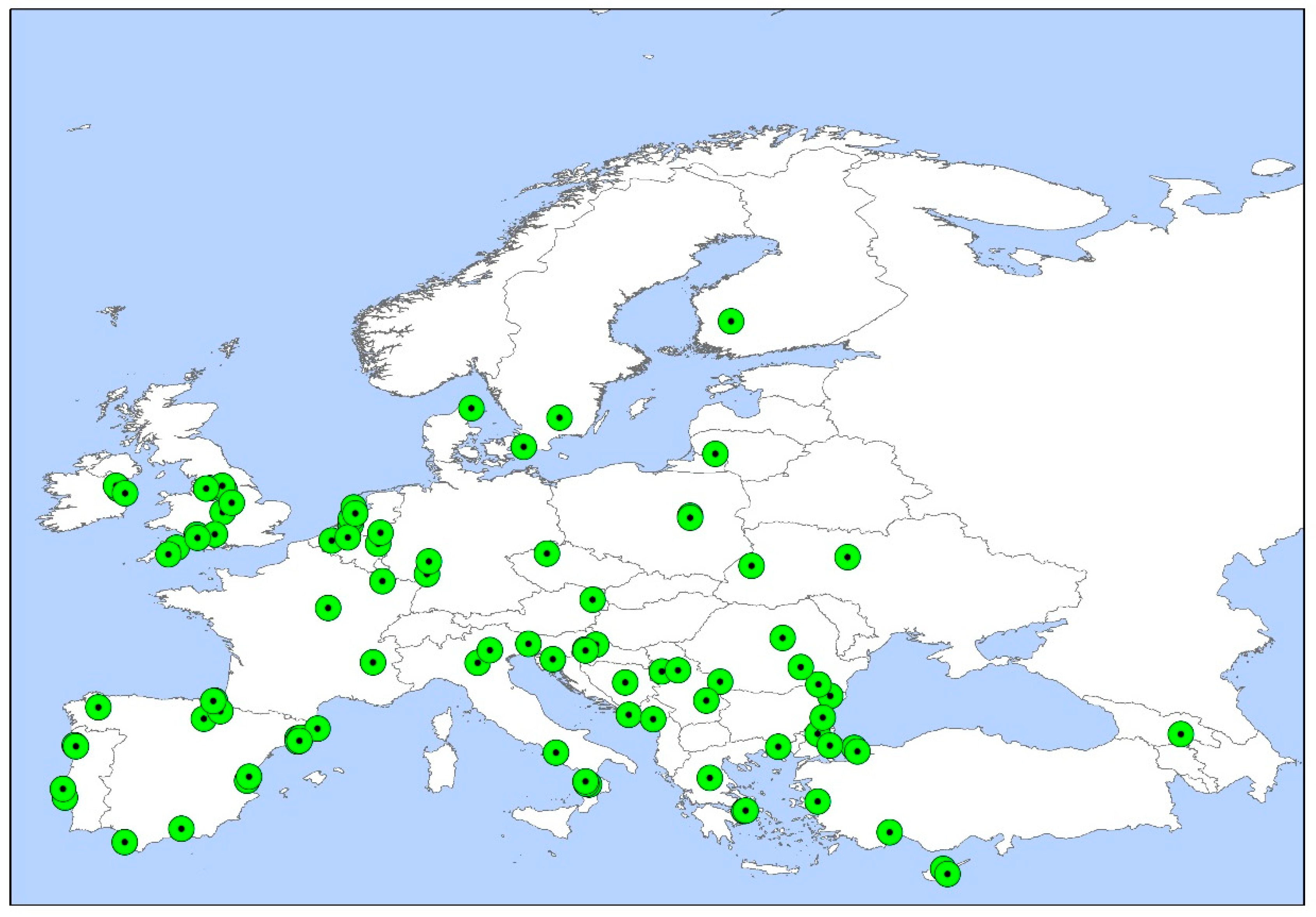

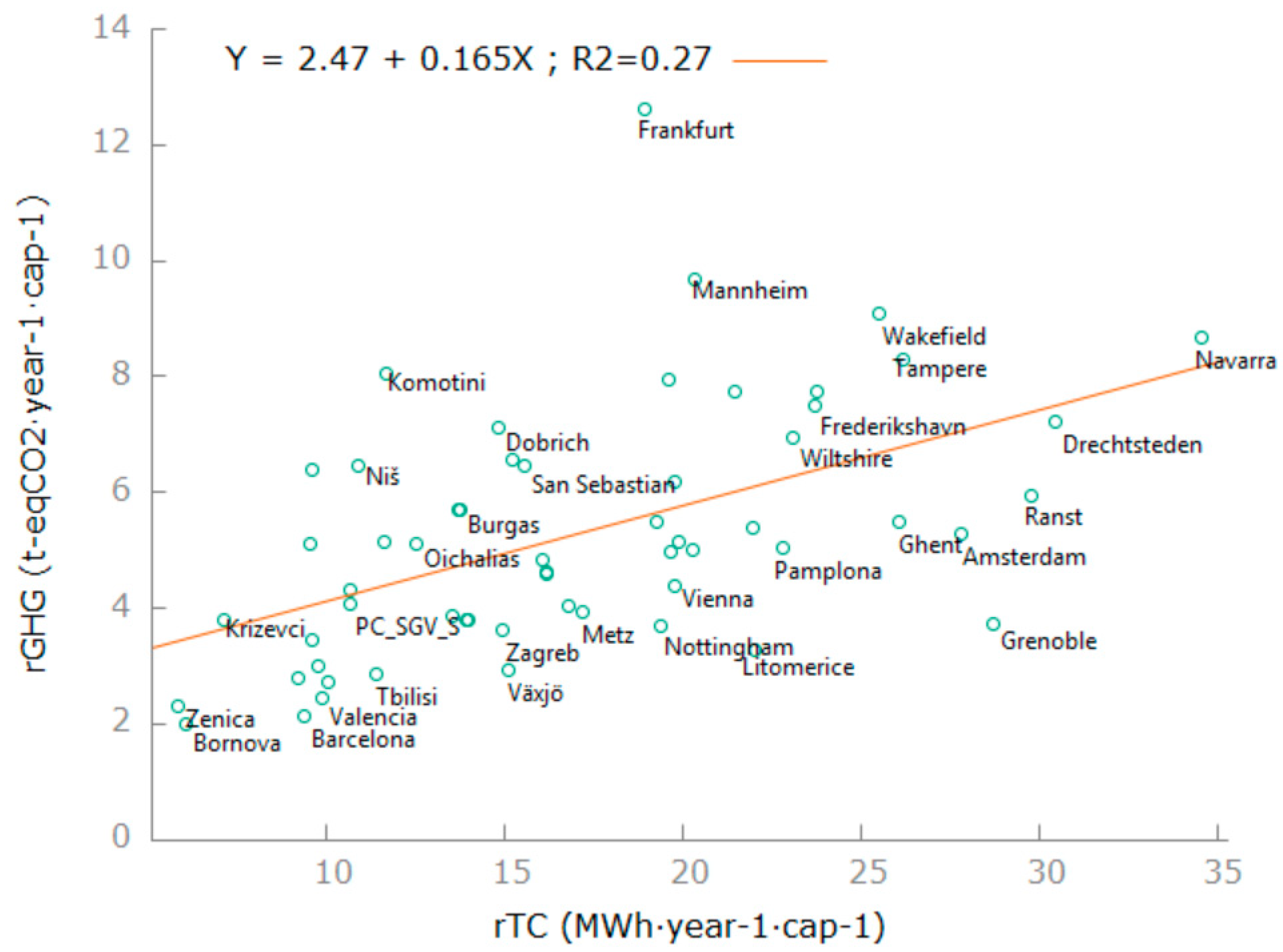
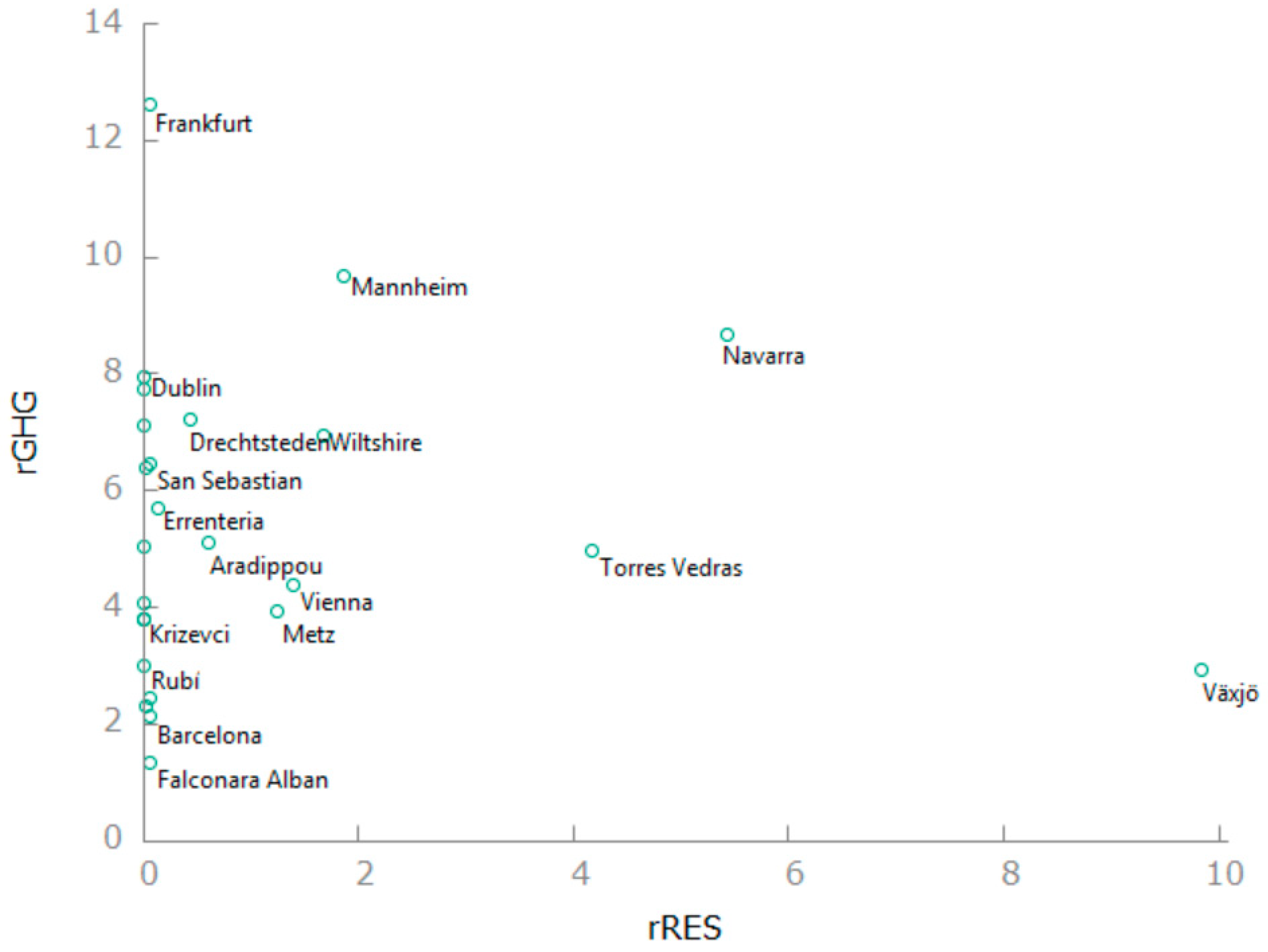
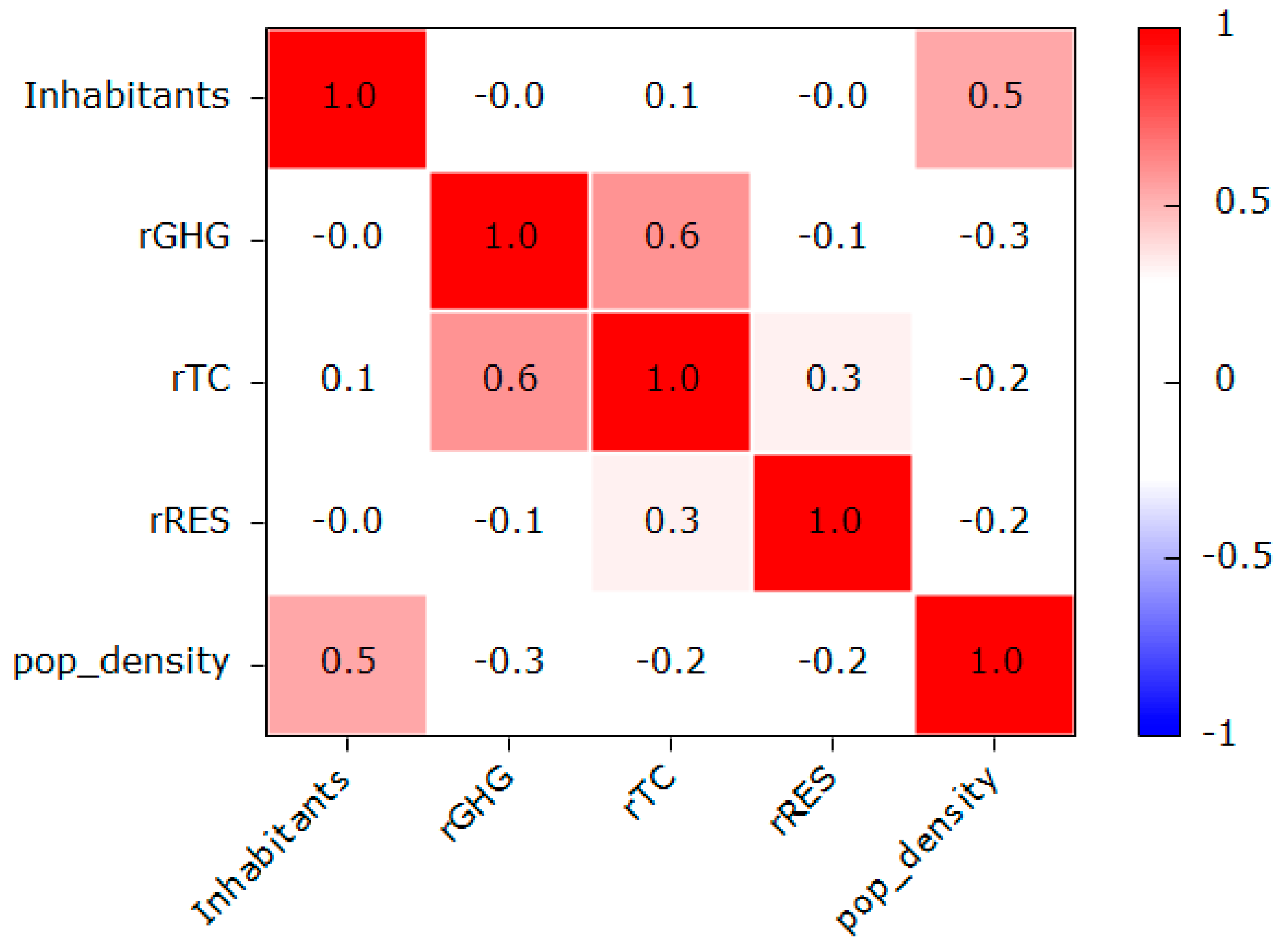


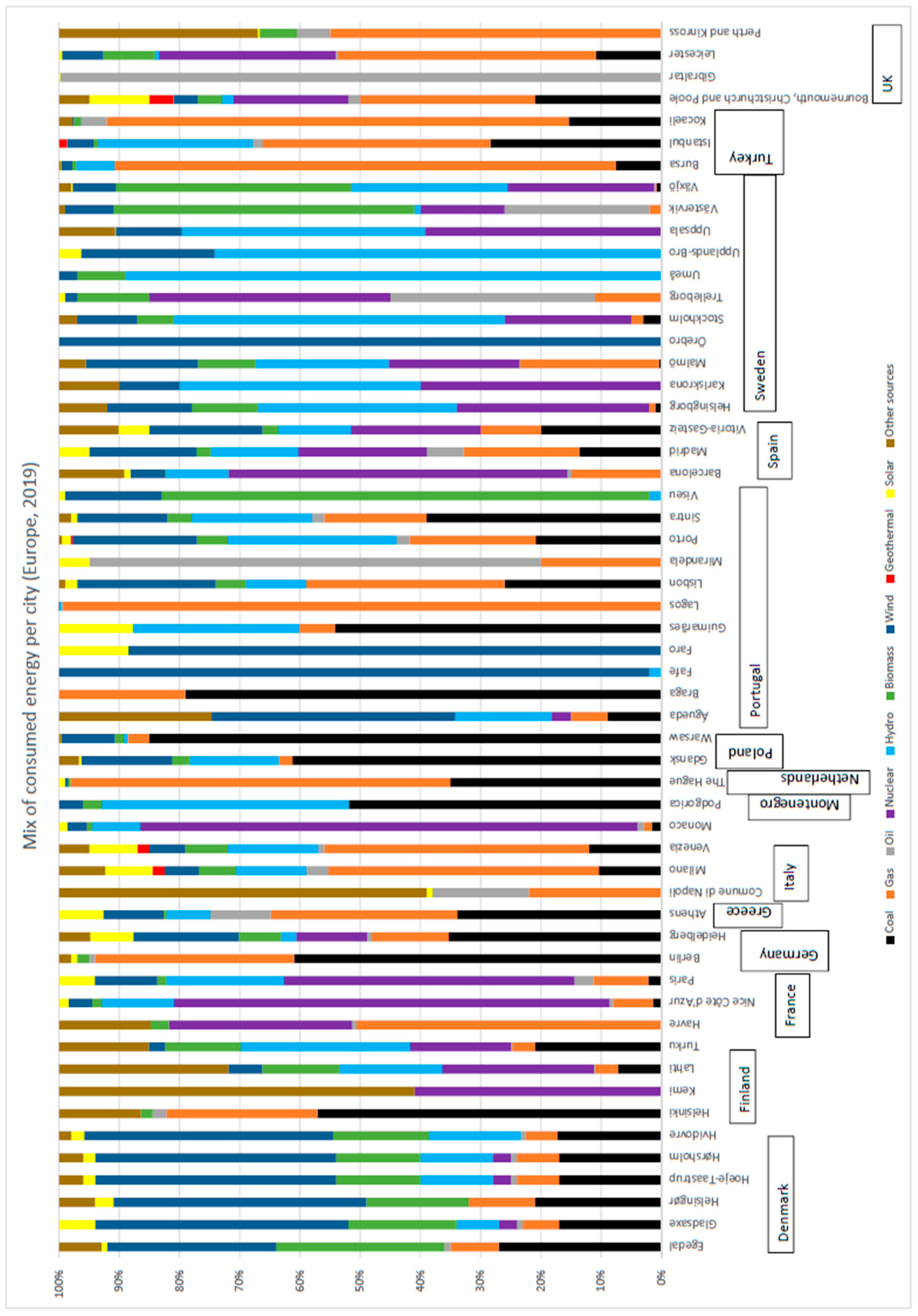
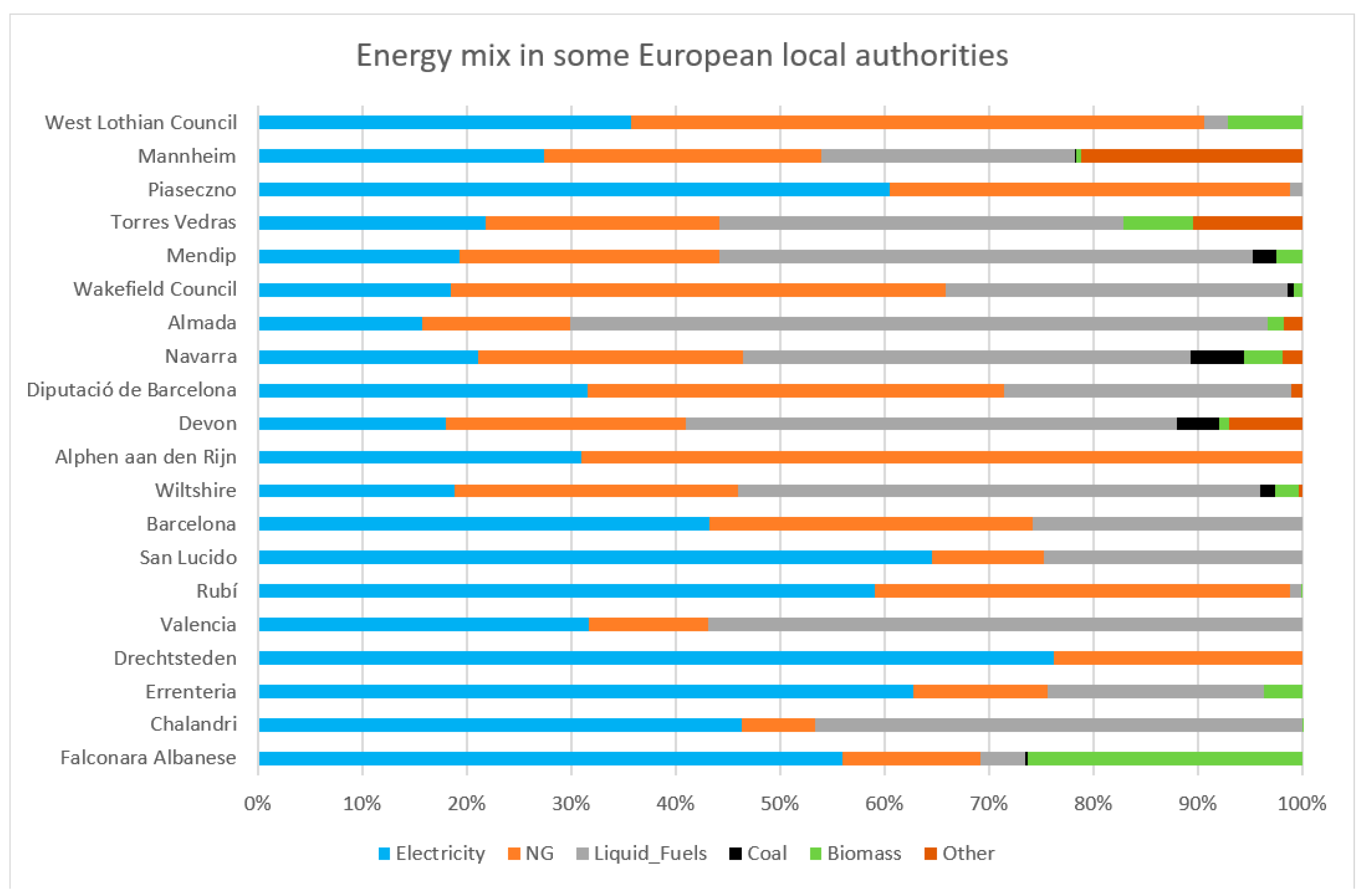

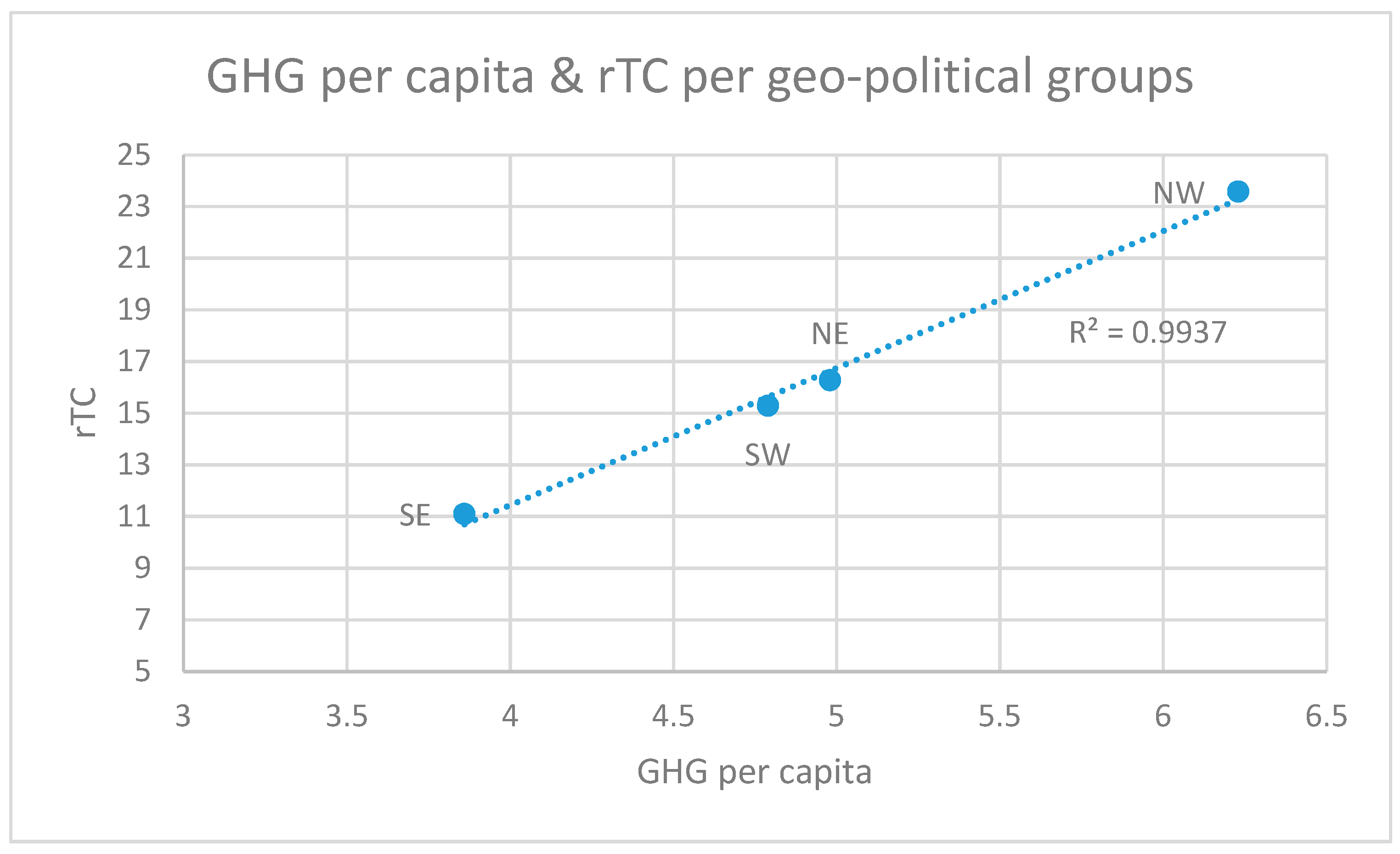
| Abbreviation | Explanation |
|---|---|
| CDD | Cooling Degree Days |
| CF | Capacity Factor. |
| EmR | Emission Rate: GHG emissions per consumed energy unit |
| EU | European Union |
| GHG | Greenhouse Gas |
| HDD | Heating Degree Days |
| IEA | International Energy Agency |
| RES | Renewable Energy Source |
| rBudget | per capita energy transition budget |
| rGHG | per capita greenhouse gas emissions |
| rRES | per capita renewable energy generated |
| rStaff | per capita employees in energy transition issues |
| rTC | per capita total energy consumption |
| TC | Total energy Consumption |
| Area | Countries Considered within Each Group |
|---|---|
| NE | Estonia, Latvia, Lithuania, Poland, Ukraine, Czech Republic, Slovakia, Moldavia. |
| NW | Iceland, Ireland, UK, Norway, Sweden, Finland, Denmark, Germany, Belgium, Netherlands, France, Austria. |
| SE | Hungary, Slovenia, Croatia, Bosnia & Her., Serbia, Montenegro, Kosovo, Macedonia, Albania, Romania, Bulgaria, Turkey, Georgia. |
| SW | Portugal, Spain, Italy, Greece, Cyprus. |
| Variable | Gathered Data (%) | Data Year Average | % Data from Local Authority |
|---|---|---|---|
| Renewable generation data | 36–41 | 2017 | 78 |
| Energy consumption per primary energy | 19–74 | 2015 | 84 |
| Total energy consumption data | 78 | 2013 | - |
| GHG emission data | 80 | 2015 | 36 |
| Budget and staff data | 16–43 | 2019 | 100 |
| Energy transition campaigns data | 38–51 | 2019 | 45 |
Publisher’s Note: MDPI stays neutral with regard to jurisdictional claims in published maps and institutional affiliations. |
© 2021 by the authors. Licensee MDPI, Basel, Switzerland. This article is an open access article distributed under the terms and conditions of the Creative Commons Attribution (CC BY) license (https://creativecommons.org/licenses/by/4.0/).
Share and Cite
Azurza-Zubizarreta, O.; Basurko-PerezdeArenaza, I.; Zelarain, E.; Villamor, E.; Akizu-Gardoki, O.; Villena-Camarero, U.; Campos-Celador, A.; Barcena-Hinojal, I. Urban Energy Transitions in Europe, towards Low-Socio-Environmental Impact Cities. Sustainability 2021, 13, 11641. https://doi.org/10.3390/su132111641
Azurza-Zubizarreta O, Basurko-PerezdeArenaza I, Zelarain E, Villamor E, Akizu-Gardoki O, Villena-Camarero U, Campos-Celador A, Barcena-Hinojal I. Urban Energy Transitions in Europe, towards Low-Socio-Environmental Impact Cities. Sustainability. 2021; 13(21):11641. https://doi.org/10.3390/su132111641
Chicago/Turabian StyleAzurza-Zubizarreta, Olatz, Izaro Basurko-PerezdeArenaza, Eñaut Zelarain, Estitxu Villamor, Ortzi Akizu-Gardoki, Unai Villena-Camarero, Alvaro Campos-Celador, and Iñaki Barcena-Hinojal. 2021. "Urban Energy Transitions in Europe, towards Low-Socio-Environmental Impact Cities" Sustainability 13, no. 21: 11641. https://doi.org/10.3390/su132111641
APA StyleAzurza-Zubizarreta, O., Basurko-PerezdeArenaza, I., Zelarain, E., Villamor, E., Akizu-Gardoki, O., Villena-Camarero, U., Campos-Celador, A., & Barcena-Hinojal, I. (2021). Urban Energy Transitions in Europe, towards Low-Socio-Environmental Impact Cities. Sustainability, 13(21), 11641. https://doi.org/10.3390/su132111641







